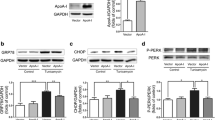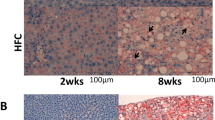Abstract
Endoplasmic reticulum stress (ERS) has been found in non-alcoholic fatty liver disease. The study was to further explore the mechanistic relationship between ERS and lipid accumulation. To induce ERS, the hepatoblastoma cell line HepG2 and the normal human L02 cell line were exposed to Tg for 48 h. RT-PCR and Western blot were performed to evaluate glucose-regulated protein (GRP-78) expression as a marker of ERS. ER ultrastructure was assessed by electron microscopy. Triglyceride content was examined by Oil Red O staining and quantitative intracellular triglyceride assay. The hepatic nuclear sterol regulatory element-binding protein (SREBP-1c), liver X receptor (LXRs), fatty acid synthase (FAS), and acetyl-coA carboxylase (ACC1) expressions were examined by real-time PCR and Western blot. 4-(2-aminoethyl) benzenesulfonyl fluoride (AEBSF) was used to inhibit S1P serine protease inhibitor, and SREBP-1c cleavage was evaluated under ERS. SREBP-1c was knockdown and its effect on lipid metabolism was observed. Tg treatment upregulated GRP-78 expression and severely damaged the ER structure in L02 and HepG2 cells. ERS increased triglyceride deposition and enhanced the expression of SREBP-1c, FAS, and ACC1, but have no influence on LXR. AEBSF pretreatment abolished Tg-induced SREBP-1c cleavage. Moreover, SREBP-1c silencing reduced triglycerides and downregulated FAS expression. Pharmacological ERS induced by Tg leads to lipid accumulation through upregulation of SREBP-1c in L02 and HepG2 cells.








Similar content being viewed by others
Abbreviations
- ERS:
-
Endoplasmic reticulum stress
- GRP-78:
-
Glucose-regulated protein
- NAFLD:
-
Non-alcoholic fatty liver disease
- Tg:
-
Thapsigargin
- ACC1:
-
Acetyl-CoA carboxylase
- FAS:
-
Fatty acid synthase
- LXR:
-
Liver X receptor
- S1P:
-
Site 1 protease
- SCAP:
-
SREBP cleavage-activating protein
- SREBP-1c:
-
Sterol regulatory element-binding protein 1c
- Insig-1:
-
Insulin-induced gene 1
- AEBSF:
-
4-(2-Aminoethyl) benzenesulfonyl fluoride hydrochloride
- UPR:
-
Unfolded protein response
References
Pagliassotti MJ (2012) Endoplasmic reticulum stress in nonalcoholic fatty liver disease. Annu Rev Nutr 32:17–33
Donnelly KL, Smith CI, Schwarzenberg SJ et al (2005) Sources of fatty acids stored in liver and secreted via lipoproteins in patients with nonalcoholic fatty liver disease. J Clin Invest 115:1343–1351
Galligan JJ, Smathers RL, Shearn CT et al (2012) Oxidative stress and the ER stress response in a murine model for early-stage alcoholic liver disease. J Toxicol 2012:article ID 207594, 12. doi:10.1155/2012/207594
Schroder M, Kaufman RJ (2005) ER stress and the unfolded protein response. Mutat Res 569:29–63
Sato Ryuichiro (2010) Sterol metabolism and SREBP activation. Arch Biochem Biophys 501(2):177–181
Esfandiari F, Medici V, Wong DH et al (2010) Epigenetic regulation of hepatic endoplasmic reticulum stress pathways in the ethanol-fed cystathionine beta synthase-deficient mouse. Hepatology 51(3):932–941
Knebel B, Haas J, Hartwig S et al (2012) Liver-specific expression of transcriptionally active SREBP-1c is associated with fatty liver and increased visceral fat mass. PLoS One 7(2):e31812
Horton JD, Goldstein JL, Brown MS (2002) SREBPs: activators of the complete program of cholesterol and fatty acid synthesis in the liver. J Clin Invest 109:1125–1131
Hotamisligil GS (2010) Endoplasmic reticulum stress and the inflammatory basis of metabolic disease. Cell 140(6):900–917
Esfandiari F, Villanueva JA, Wong DH et al (2005) Chronic ethanol feeding and folate deficiency activate hepatic endoplasmic reticulum stress pathway in micropigs. Am J Physiol Gastrointest Liver Physiol 289(1):54–63
Werstuck GH, Lentz SR, Dayal S et al (2001) Homocysteine-induced endoplasmic reticulum stress causes dysregulation of the cholesterol and triglyceride biosynthetic pathways. J Clin Invest 107:1263–1273
Damiano F, Alemanno S, Gnoni GV, Siculella L (2010) Translational control of the sterol-regulatory transcription factor SREBP-1 mRNA in response to serum starvation or ER stress is mediated by an internal ribosome entry site. Biochem J 429:603–612
Ji C, Shinohara M, Kuhlenkamp J, Chan C, Kaplowitz N (2007) Mechanisms of protection by the betaine-homocysteine methyltransferase/betaine system in HepG2 cells and primary mouse hepatocytes. Hepatology 46:1586–1596
Masserdotti Carlo, Bonfanti Ugo, De Lorenzi Davide et al (2006) Use of Oil red O stain in the cytologic diagnosis of canine liposarcoma. Vet Clin Pathol 35(1):37–41
de Alwis NM, Day CP (2008) Non-alcoholic fatty liver disease: the mist gradually clears. J Hepatol 48(s1):s104–s112
Flamment M, Kammoun HL, Hainault I et al (2010) Endoplasmic reticulum stress: a new actor in the development of hepatic steatosis. Curr Opin Lipidol 21(3):239–246
Dara L, Ji C, Kaplowitz N (2011) The contribution of endoplasmic reticulum stress to liver diseases. Hepatology 53(5):1752–1763
Liu Jiang, Jin Xi, Chao-Hui Yu et al (2010) Endoplasmic reticulum stress involved in the course of lipogenesis in fatty acids-induced hepatic steatosis. J Gastroenterol Hepatol 25(3):613–618
Zhang C, Chen X, Zhu RM et al (2012) Endoplasmic reticulum stress is involved in hepatic SREBP-1c activation and lipid accumulation in fructose-fed mice. Toxicol Lett 212(3):229–240
Puri P, Mirshahi F, Cheung O et al (2008) Activation and dysregulation of the unfolded protein response in nonalcoholic fatty liver disease. Gastroenterology 134(2):568–576
Rutkowski DT, Wu J, Back SH, Callaghan MU et al (2008) UPR pathways combine to prevent hepatic steatosis caused by ER stress-mediated suppression of transcriptional master regulators. Dev Cell 15(6):829–840
Lee AS (2005) The ER chaperone and signaling regulator GRP78/BiP as a monitor of endoplasmic reticulum stress. Methods 35(4):373–381
Amodio G, Renna M, Paladino S et al (2009) Endoplasmic reticulum stress reduces the export from the ER and alters the architecture of post-ER compartments. Int J Biochem Cell Biol 41(12):2511–2521
Lee JS, Mendez R, Heng HH, Yang ZQ, Zhang KZ (2012) Pharmacological ER stress promotes hepatic lipogenesis and lipid droplet formation. Am J Transl Res 4(1):102–113
Hélèe LK, Hervé Chabanon, Isabelle Hainault et al (2009) GRP78 expression inhibits insulin and ER stress-induced SREBP-1c activation and reduces hepatic steatosis in mice. J Clin Invest 119(5):1201–1215
Ferre P, Foufelle F (2010) Hepatic steatosis: a role for de novo lipogenesis and the [transcription factor SREBP-1c. Diabetes Obes Metab 2:83–92
Jun H, Song Z, Chen W et al (2009) In vivo and in vitro effects of SREBP-1 on diabetic renal tubular lipid accumulation and RNAi-mediated gene silencing study. Histochem Cell Biol 131(3):327–345
Okada T, Haze K, Nadanaka S et al (2003) A serine protease inhibitor prevents endoplasmic reticulum stress-induced cleavage but not transport of the membrane-bound transcription factor ATF6. J Biol Chem 278(33):31024–31032
Maclean KN, Greiner LS, Enans JR et al (2012) Cystathionine protects against endoplasmic reticulum stress induced lipid accumulation, tissue injury and apoptotic cell death. J Biol Chem 287(38):31994–32005
Acknowledgments
This study was supported by the Natural Science Foundation of China (no. 81000357). We thank the staff of the Department of Gastroenterology and Hepatology of the Second Affiliated Hospital of Chongqing Medical University for their help. We also thank Ms. Yingxia Xiang and Mr. Jing Wang for the consistent technical assistance and Medjaden Bioscience for assisting in the preparation of this manuscript.
Author information
Authors and Affiliations
Corresponding author
Additional information
Dian-liang Fang and Ying Wan are co-first authors.
Rights and permissions
About this article
Cite this article
Fang, Dl., Wan, Y., Shen, W. et al. Endoplasmic reticulum stress leads to lipid accumulation through upregulation of SREBP-1c in normal hepatic and hepatoma cells. Mol Cell Biochem 381, 127–137 (2013). https://doi.org/10.1007/s11010-013-1694-7
Received:
Accepted:
Published:
Issue Date:
DOI: https://doi.org/10.1007/s11010-013-1694-7




